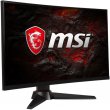 The Micro-Star International vendor has announced the forthcoming market entry of its 27-inch Optix MAG27CQ gaming monitor, which is to become a real flagship in the Taiwan manufacturer’s product range.
The Micro-Star International vendor has announced the forthcoming market entry of its 27-inch Optix MAG27CQ gaming monitor, which is to become a real flagship in the Taiwan manufacturer’s product range.The device is built on the curved VA panel, featuring the 2,560 x 1,440 pixels resolution and ensuring the 110 % coverage of the sRGB colour gamut. Among its peculiarities one may distinguish the high refresh rate and the AMD FreeSync technology support.
The MSI Optix MAG27CQ display has the 1,800 mm curvature radius, 250 cd/m² brightness and 3000:1 static contrast ratio. The ultimate refresh rate is 144 Hz, and the response time declared equals 1 ms. The novelty possesses standard (for VA panels) viewing angles, which are 178° in horizontal and vertical directions. An image source can be linked via HDMI, DisplayPort and DVI ports.
This latest gaming solution has already started to hit European Dot Coms’ …
 Sharkoon has rejoiced its budget-oriented admirers with a new series of PC cases, entitled VG4-S. The greenhorns are distinguished by a decent functionality combined with an alluring price. Featuring 445x200x430 mm dimensions, the case is ready to offer enough space for a set of up-to-date internal components and welcomes the connection of various external devices. Moreover, the model is housed in a black chassis, while perforated areas are illuminated by red/green/blue backlight.
Sharkoon has rejoiced its budget-oriented admirers with a new series of PC cases, entitled VG4-S. The greenhorns are distinguished by a decent functionality combined with an alluring price. Featuring 445x200x430 mm dimensions, the case is ready to offer enough space for a set of up-to-date internal components and welcomes the connection of various external devices. Moreover, the model is housed in a black chassis, while perforated areas are illuminated by red/green/blue backlight.  In the year of 2015 the Intel Company announced a mini PC with a completely new layout, named Intel Compute Stick. According to its dimensions it resembles a mobile 3G adapter or a slightly enlarged typical flash drive, though its functionality lets us consider this sample to be a fully-featured PC, which only needs to be connected to the monitor or TV-set through the HDMI interface.
In the year of 2015 the Intel Company announced a mini PC with a completely new layout, named Intel Compute Stick. According to its dimensions it resembles a mobile 3G adapter or a slightly enlarged typical flash drive, though its functionality lets us consider this sample to be a fully-featured PC, which only needs to be connected to the monitor or TV-set through the HDMI interface.